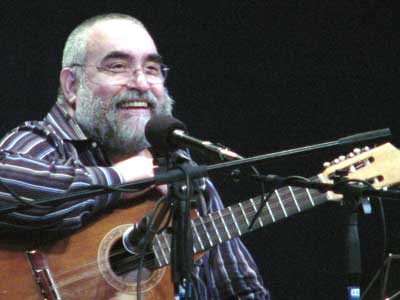11.7.9 Pedro Luis Ferrer.

Pedro Luis Ferrer, Cuban guitarist, composer, and singer. He was born on September 17, 1952, in Yaguajay, north of Sancti Spíritus. He grew up in a family devoted to popular and festive poetry. Some time later, he moved to Havana, where he attended sixth grade. He attended school rarely, but made several attempts to finish his first year of secondary school. His musical training was self-taught.
In the 1960s, he began joining small musical groups that were unsuccessfully attempting to become professional. Pedro Luis Ferrer met Carlos Alfonso (director of Grupo Síntesis) when he was a member of the Los Nova quartet. With him, he learned and experimented with vocal work for the first time, and came into contact with up-to-date sources of popular music.
He later joined the rock group Los Dada, where he interacted with Alfredo Areas and Mike Pourcel. Pianist Víctor Zayas introduced him to the art of orchestration.
In 1973, he began his professional career as a troubadour, and in the middle of that decade, he recorded his first LP, entitled “Pedro Luis Ferrer.” It features the songs “Mariposa” and “Romance de la Niña Mala.” During this time, he also traveled to Europe for the first time, to countries such as Poland, Finland, Norway, and Sweden.
He plays on the guitar works by great composers (Leo Brouwer, Carlos Fariñas, Harold Gramatches, Edgardo Martín, Isaac Albéniz, among others) with which he surpasses and expands his knowledge as a self-taught artist.
In the 1980s, Pedro Luis Ferrer founded his own group. He also recorded two LPs: “Debajo de mi voz” (Under My Voice) and “Espuma y Arena” (Spume and Sand). This was a period in which he worked for several documentaries and films produced by the then FAR Film Section. He traveled with his group to the Republic of Angola, then traveled again to Europe and Latin America.
In the 1990s, he briefly worked with the FAR Artistic Ensemble in Guantánamo, where he became acquainted with the Changüí style and other important musical talents from that territory. He traveled to the United States on several occasions, giving concerts in cities such as New Orleans and Miami. He released his first album, “Ciento por ciento cubano,” abroad. He also toured Germany twice.
In 1998, Pedro Luis performed with his daughter Lena Ferrer in Germany and Switzerland. He signed an exclusive publishing and recording contract with Harbour Bridge. In 1999, he toured the United States. In August of that year, he gave two concerts in the Avellaneda Hall of the National Theater (39th Street between Paseo and Carlos Manuel de Céspedes Avenue, Plaza de la Revolución, Havana).
In the 2000s, Ferrer continued his arduous work as a musician, releasing several albums, such as “Rústico” and “Natural.” He also toured to popularize Cuban music.
Pedro Luis’s creations have explored various genres of Cuban music, including guarachas. He has composed works for guitar and various orchestral formats. He has also created preludes and fugues for piano. He cultivates the décima, the sonnet, the redondilla, and free forms of poetry. He has also written music for television series, which have become very popular, such as “Operación Sitio.” His songs have been performed by musicians of the stature of Celia Cruz.
Among his songs are: “One Hundred Percent Cuban”, “Marucha la Jinetera”, “Grandpa Paco”, “He Has a Delusion of Loving Men”, “Amigo Palero”, “Slogans”, “All for the Same Thing”, “Bird Chain”, “The Gentleman from Paris”, “Carapacho pa’ la jicotea”, among others.
Pedro Luis Ferrer has received recognition such as the replica of Máximo Gómez’s machete, which was given to him in the 1980s.
Discography: Pedro Luis Ferrer (70s), Under my voice (70s), In foam and sand (80s), 100% Cuban (1994), Pedro Luis Ferrer (1999), Rustic (2005), Natural (2006).








